In solar power systems, accurate irradiance measurement is crucial for optimizing the performance of the PV Plant. SEVEN Irradiance Sensors deliver the critical solar data that PV professionals rely on, whether for utility-scale installations, rooftop systems, or R&D testbeds.
Built for accuracy, durability, and flexible integration, SEVEN’s range of irradiance sensors enables solar plant operators to confidently measure real-time solar radiation under any configuration or budget.
What Are Irradiance Sensors?
Irradiance sensors measure solar radiation received on a surface, typically expressed in watts per square meter (W/m²). In solar PV systems, irradiance data is essential for monitoring performance ratios and energy yield
SEVEN offers a full range of irradiance sensors, from cost-effective sensors to multi-orientation assemblies to meet diverse project needs.
SEVEN Irradiance Sensor Product Range
Standard Irradiance Sensors

Accurate and rugged sensors for single-plane irradiance monitoring, available in multiple signal output formats.
- Technology: Calibrated Reference Cell
- Output Options:
– 0–1.5 V: Ideal for simple dataloggers and analog systems
– 4–20 mA: Suitable for long-distance transmission and industrial systems
– Modbus RTU (RS485): For digital SCADA and inverter integration
- Accuracy: <1.2%, which means that it is Class A as per IEC61724-1:2021 Standard.
Low-Cost Irradiance Sensor

Ideal for budget-limited projects.
- Technology: Reference Cell without Internal Temperature Sensor
- Output: Digital (Modbus RTU)
- Accuracy: ±5%
- Best For: Residential Projects
Dual Orientation Irradiance Sensor

Simultaneously measures irradiance on two planes (e.g., east/west).
- Two reference cell sensors mounted at different angles
- A single effective irradiance value for calculating the Performance Ratio
- Best For: Dual-Orientation projects, generally rooftop projects
Multi-Orientation Irradiance Sensor

Provides irradiance data from three or four angles, ideal for advanced solar layouts.
- 3–4 calibrated sensors in one assembly
- Custom orientation setup available
- Digital output (RS485)
- Best For: Utility-scale, multi-orientation installations
Thermopile Pyranometers

For applications requiring highest-precision irradiance measurement.
- Thermopile technology
- Class A compliance (ISO 9060)
- Used in benchmarking and calibration
- Best For: Research, calibration stations, high-accuracy sites
Comparison Table of SEVEN Irradiance Sensors
| Sensor Type | Technology | Accuracy | Measuring Range | Wavelength Range | Output Options | Application |
| Standard Irradiance Sensor | Calibrated Reference Cell | ≤1% (Class A, IEC 61724-1:2021) | 0–1600 W/m² | 280–1200 nm | 0–1.5 V, 4–20 mA, Modbus RTU (RS485) | General PV plant monitoring |
| Low-Cost Irradiance Sensor | Reference Cell (no temp sensor) | ≤3% | 0–1600 W/m² | 280–1200 nm | Digital (Modbus RTU) | Residential or budget-limited projects |
| Dual Orientation Sensor | Two Reference Cells at angles | ≤1% (Class A, IEC 61724-1:2021) | 0–1600 W/m² | 280–1200 nm | Digital (Modbus RTU) | Rooftops, dual orientation PV plants |
| Multi-Orientation Sensor | 3–4 Calibrated Reference Cells | ≤1% (Class A, IEC 61724-1:2021) | 0–1600 W/m² | 280–1200 nm | Digital (Modbus RTU) | Rooftops, multi-orientation designs |
| Thermopile Pyranometer | Thermopile | Class A (ISO 9060:2018) | 0–4000 W/m² | 280–3000 nm | Digital (Modbus RTU) | Research, calibration labs, meteorology |
Key Features Across SEVEN Irradiance Sensors
- Factory-Calibrated: Each sensor is individually tested to ensure accuracy.
- Weatherproof Housing: IP54-rated for harsh outdoor environments with an available option of IP68 if required.
- Flexible Mounting: Compatible with tilt-aligned or horizontal setups.
- Modbus RTU / RS485 Available: Seamless integration into SCADA and industrial networks.
- Long-Term Stability: Built to deliver consistent readings over years of operation.
Integration & Compatibility of SEVEN Irradiance Sensors
SEVEN Irradiance Sensors are designed to work with:
- Dataloggers with sensor input ports
- SCADA systems
- Third-party dataloggers
- Monitoring platforms for performance ratio analysis
Whether analog or digital, SEVEN provides wiring and protocol documentation for easy setup and rapid deployment.
Best Practices for Installation
In order to get accurate irradiance measurement, some key tips need to be followed:
- Install sensors at the same tilt and azimuth as the PV modules.
- Clean sensor surfaces regularly to avoid dust buildup.
- Position in clear sky view, no shading from modules or cables.
- Use redundant sensors in large fields for cross-validation and fault tolerance.
SEVEN Irradiance Sensors: Clarity That Drives Performance
From budget monitoring to research-grade accuracy, SEVEN Irradiance Sensors offer a complete portfolio for measuring solar radiation with confidence. With reliable performance, rugged construction, and easy integration, they are a trusted tool for solar professionals across the globe.
Not sure which sensor is right for your application?
Contact SEVEN Team that will be glad to assist you.
